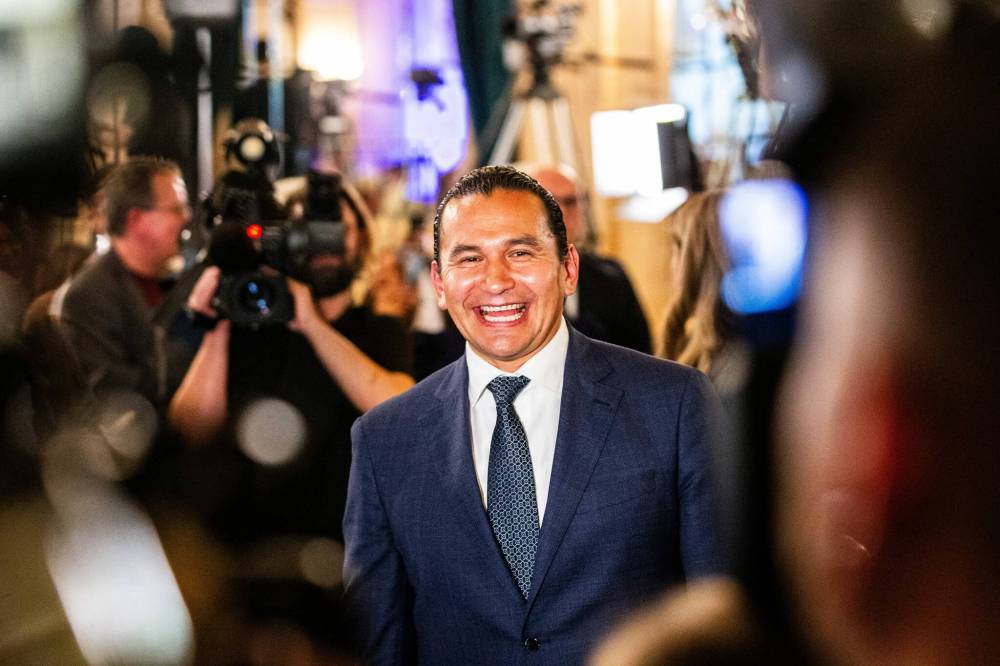There’s much more to Manitoba’s new leader than meets the eye
Advertisement
Read this article for free:
or
Already have an account? Log in here »
To continue reading, please subscribe:
Monthly Digital Subscription
$0 for the first 4 weeks*
- Enjoy unlimited reading on winnipegfreepress.com
- Read the E-Edition, our digital replica newspaper
- Access News Break, our award-winning app
- Play interactive puzzles
*No charge for 4 weeks then price increases to the regular rate of $19.00 plus GST every four weeks. Offer available to new and qualified returning subscribers only. Cancel any time.
Monthly Digital Subscription
$4.75/week*
- Enjoy unlimited reading on winnipegfreepress.com
- Read the E-Edition, our digital replica newspaper
- Access News Break, our award-winning app
- Play interactive puzzles
*Billed as $19 plus GST every four weeks. Cancel any time.
To continue reading, please subscribe:
Add Free Press access to your Brandon Sun subscription for only an additional
$1 for the first 4 weeks*
*Your next subscription payment will increase by $1.00 and you will be charged $16.99 plus GST for four weeks. After four weeks, your payment will increase to $23.99 plus GST every four weeks.
Read unlimited articles for free today:
or
Already have an account? Log in here »
Hey there, time traveller!
This article was published 04/10/2023 (790 days ago), so information in it may no longer be current.
Wab Kinew’s biography is well-known.
Most Manitobans are now familiar with his history as a rapper, reporter, administrator, activist and writer.
Thanks to reporters, social media and Progressive Conservative party attack ads, most also know his past legal and personal troubles, too.
Fewer are familiar with other — but equally as important — aspects of his life: he’s a father, an avid hockey fan and has both a bachelor’s degree in economics and a master’s in Indigenous governance.
He is an imported Manitoban, born in Kenora and raised on Onigaming First Nation in Treaty Three (in northwestern Ontario) before his family moved to Winnipeg.
He’s also the son of well-known Anishinaabe leader and traditional knowledge keeper Tobasonakwut Kinew and Kathi Kinew, a respected colleague of mine in the department of Indigenous studies at the University of Manitoba (she retired in the spring).
MIKAELA MACKENZIE / WINNIPEG FREE PRESS Premier-designate Wab Kinew celebrates his party’s victory Tuesday. 
He’s a pipe carrier; for Indigenous people that means he’s assigned to bring people together whenever required.
He’s a traditional singer (hand drum and big drum) and is a Sundance and Midéwiwin practitioner — ceremonial institutions in Indigenous communities.
He also (remarkably, for anyone who knows) fulfilled a dream later in his life and became a powwow dancer — sewing regalia and performing the difficult style of the Prairie Chicken Dance, which symbolizes the strong interconnection Indigenous peoples have with nature and wildlife.
Now, he can add making history as the first provincial First Nations premier-designate to his long list of accomplishments.
Manitoba had two Métis leaders at the helm (Louis Riel and John Norquay) in the late 19th century and northern territories have had numerous Indigenous premiers.
In the Indigenous world, though, credentials are recognized somewhat differently.
Culture, ancestry and community matters, of course, but what Indigenous peoples want to know first and foremost is someone’s name and clan. These are the first things Indigenous peoples share in a traditional greeting.
In other words, Wab Kinew doesn’t start his speeches in Indigenous communities with his familiar folksy: “How do you do, I’m Wab Kinew,” but his name and clan, information Indigenous peoples use to locate him, his work and what gifts he is offering.
His traditional name is Wabanakwut, which in the Anishinaabe language means the “early morning grey cloud.”
Wab: wisdom, dignity, honour
That term breaks down into two parts: “Wab” and “anakwut.”
The “Wab” part means “white,” but not just any shade of white. It’s a shortened version of “waabishiki,” meaning a white colour that reflects light and appears bright, shiny and even grey (such as limestone, for example). This sort of white carries with it a sense of wisdom, dignity and honour — like the colour hair becomes as people age.
This colour has deep spiritual meaning, too. The word “waabashki-mukwa,” for example, means white or “polar” bear, and also how that being demonstrates reverence and healing.
In the Anishinaabe language, words also don’t just describe but articulate actions. “Wab” therefore draws upon “waaban,” which means “dawn” or “the sunrise of a new day.”
A sign of a new day is when clouds appear in the sky. Reflecting light, these clouds are distinct, unique and often grey. These are called anakwut (singular) or anakwutoka (plural).
Wabanakwut, therefore, means a bright, shiny, distinct grey cloud — an image that appears when a new day is here and, thus, the arrival of wisdom, dignity and honour.
This is a remarkably symbolic name to carry, no doubt, but he carries another name, as well.
Kinew: Golden eagle
His ancestral name, Kinew, means the golden eagle — a solitary, powerful being who gathers food and travels across a vast amount of territory (up to 200 kilometres from the nest).
Golden eagles also fly high in the sky and carry the teaching of leadership. This is signified by the eagle feathers Anishinaabe people wear on headdresses and in their hair (as Kinew does).
Wearing an eagle feather means trying to see as eagles do; from the highest vantage, viewing a territory without divisions such as race, gender and class and trying to envision a place where humans, animals, birds, fish, earth, water and sky can all work together.
Like all Anishinaabe people, Wabanakwut Kinew also carries a totem, or clan — the spiritual being his family and lineage learns from and is most connected to.
Lynx: warrior, leader
This is “bizhiw,” or lynx. Lynx clan members among Anishinaabe carry a very important and sacred duty: to protect our nation.
They are warriors, leaders and spokespeople.
Like a bizhiw, lynx clan members are saavy, smart and carefully measure every step they take. In traditional times, they often would be sent first to new territories, tasked with the job of investigating, making new relationships and beginning the process of treaty-making.
Members of the bizhiw totem would therefore be one of the most important advisers for Anishinaabe people, for they must stay grounded in traditional ways but keep an eye on how traditions require change, growth and bravery to continue.
So, as the Indigenous community knows him, meet your new premier-designate. You may know him as “Wab” but he is so much more.
niigaan.sinclair@freepress.mb.ca

Niigaan Sinclair is Anishinaabe and is a columnist at the Winnipeg Free Press.
Our newsroom depends on a growing audience of readers to power our journalism. If you are not a paid reader, please consider becoming a subscriber.
Our newsroom depends on its audience of readers to power our journalism. Thank you for your support.















